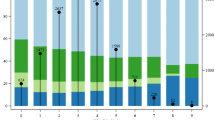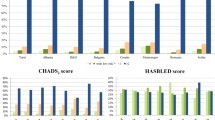Abstract
Background
Little is known about prescription trends in atrial fibrillation (AF) in primary health care in Sweden.
Objective
The aim was to study time trends in pharmacotherapy, in men and women with AF. We also aimed at studying doctors’ adherence to CHADS2 for prescribing warfarin. CHADS2 assesses stroke risk by presence of known risk factors, i.e., congestive heart failure, hypertension, age >75 years, diabetes, previous stroke and transient ischemic attack.
Methods
Data were obtained from primary health care records that contained individual clinical data. In total, 371,036 patients were included in the sample from 2002, and 424,329 patients were included in the sample from 2007. The study population consisted of individuals aged 45+ years who were diagnosed with AF in 2002 (1,330 men and 1,096 women) and 2007 (2,748 men and 2,234 women). The pharmacotherapies prescribed in 2002 and 2007 were analyzed separately in men and women. Logistic regression was used to calculate the association between the CHADS2 score and prescribed warfarin treatment.
Results
Selective beta-blockers, anti-coagulant therapy and lipid-lowering drugs were prescribed more frequently in 2007 than in 2002. In 2007, antithrombotic and RAS-blocking agents were prescribed more frequently to men, whereas beta-1 selective beta-blockers were prescribed more frequently to women. There was no consistent association between the CHADS2 score and prescribed warfarin treatment.
Conclusions
Pharmacotherapy of AF has improved over time, though CHADS2 guidelines need to be implemented systematically in primary health care in Sweden to decrease the risk of stroke and improve quality of life in patients with AF.
Similar content being viewed by others
References
Michelena HI, Powell BD, Brady PA, Friedman PA, Ezekowitz MD (2010) Gender in atrial fibrillation: ten years later. Gend Med 7(3):206–217. doi:10.1016/j.genm.2010.06.001
Wandell PE (2001) A survey of subjects with present or previous atrial fibrillation in a Swedish community. Scand J Prim Health Care 19(1):20–24
Volgman AS, Manankil MF, Mookherjee D, Trohman RG (2009) Women with atrial fibrillation: greater risk, less attention. Gend Med 6(3):419–432. doi:10.1016/j.genm.2009.09.008
Naccarelli GV, Varker H, Lin J, Schulman KL (2009) Increasing prevalence of atrial fibrillation and flutter in the United States. Am J Cardiol 104(11):1534–1539. doi:10.1016/j.amjcard.2009.07.022
Friberg J, Scharling H, Gadsboll N, Truelsen T, Jensen GB (2004) Comparison of the impact of atrial fibrillation on the risk of stroke and cardiovascular death in women versus men (The Copenhagen City Heart Study). Am J Cardiol 94(7):889–894. doi:10.1016/j.amjcard.2004.06.023
van Walraven C, Hart RG, Connolly S, Austin PC, Mant J, Hobbs FD, Koudstaal PJ, Petersen P, Perez-Gomez F, Knottnerus JA, Boode B, Ezekowitz MD, Singer DE (2009) Effect of age on stroke prevention therapy in patients with atrial fibrillation: the atrial fibrillation investigators. Stroke 40(4):1410–1416. doi:10.1161/STROKEAHA.108.526988
van Walraven C, Hart RG, Singer DE, Koudstaal PJ, Connolly S (2003) Oral anticoagulants vs. aspirin for stroke prevention in patients with non-valvular atrial fibrillation: the verdict is in. Card Electrophysiol Rev 7(4):374–378. doi:10.1023/B:CEPR.0000023143.98705.ee
van Walraven C, Hart RG, Singer DE, Laupacis A, Connolly S, Petersen P, Koudstaal PJ, Chang Y, Hellemons B (2002) Oral anticoagulants vs aspirin in nonvalvular atrial fibrillation: an individual patient meta-analysis. JAMA 288(19):2441–2448
Fang MC, Go AS, Chang Y, Borowsky L, Pomernacki NK, Singer DE (2008) Comparison of risk stratification schemes to predict thromboembolism in people with nonvalvular atrial fibrillation. J Am Coll Cardiol 51(8):810–815. doi:10.1016/j.jacc.2007.09.065
Go AS, Hylek EM, Borowsky LH, Phillips KA, Selby JV, Singer DE (1999) Warfarin use among ambulatory patients with nonvalvular atrial fibrillation: the anticoagulation and risk factors in atrial fibrillation (ATRIA) study. Ann Intern Med 131(12):927–934
Go AS, Hylek EM, Phillips KA, Borowsky LH, Henault LE, Chang Y, Selby JV, Singer DE (2000) Implications of stroke risk criteria on the anticoagulation decision in nonvalvular atrial fibrillation: the Anticoagulation and Risk Factors in Atrial Fibrillation (ATRIA) study. Circulation 102(1):11–13
Singer DE, Chang Y, Fang MC, Borowsky LH, Pomernacki NK, Udaltsova N, Go AS (2009) The net clinical benefit of warfarin anticoagulation in atrial fibrillation. Ann Intern Med 151(5):297–305
Henriksson KM, Farahmand B, Johansson S, Asberg S, Terent A, Edvardsson N (2010) Survival after stroke–the impact of CHADS2 score and atrial fibrillation. Int J Cardiol 141(1):18–23. doi:10.1016/j.ijcard.2008.11.122
Wandell PE (1999) Drug use in patients with atrial fibrillation in Swedish primary health care: a comparison 5 years apart. Eur J Clin Pharmacol 55(4):333–337
Hemminki K, Li X, Sundquist K (2007) Familial risks for nerve, nerve root and plexus disorders in siblings based on hospitalisations in Sweden. J Epidemiol Community Health 61(1):80–84. doi:10.1136/jech.2006.046615
Li X, Sundquist J, Sundquist K (2008) Socioeconomic and occupational risk factors for rheumatoid arthritis: a nationwide study based on hospitalizations in Sweden. J Rheumatol 35(6):986–991
Sundquist K, Li X (2006) Coronary heart disease risks in first- and second-generation immigrants in Sweden: a follow-up study. J Intern Med 259(4):418–427. doi:10.1111/j.1365-2796.2006.01630.x
Wandell PE, Carlsson AC, Sundquist K, Johansson SE, Sundquist J (2011) Total mortality among levothyroxine-treated women with atrial fibrillation in Swedish primary health care. Int J Cardiol 152(1):147–148. doi:10.1016/j.ijcard.2011.07.066
Carlsson AC, Wandell PE, Journath G, de Faire U, Hellenius ML (2009) Factors associated with uncontrolled hypertension and cardiovascular risk in hypertensive 60-year-old men and women–a population-based study. Hypertens Res 32(9):780–785. doi:10.1038/hr.2009.94
Journath G, Hellenius ML, Carlsson AC, Wandell PE, Nilsson PM (2010) Physicians' gender is associated with risk factor control in patients on antihypertensive and lipid lowering treatment. Blood Press 19(4):240–248. doi:10.3109/08037051003768247
Pimenta E, Stowasser M (2009) Uncontrolled hypertension: beyond pharmacological treatment. Hypertens Res 32(9):729–731. doi:10.1038/hr.2009.108
Glader EL, Sjolander M, Eriksson M, Lundberg M (2010) Persistent use of secondary preventive drugs declines rapidly during the first 2 years after stroke. Stroke 41(2):397–401. doi:10.1161/STROKEAHA.109.566950
Humphries KH, Kerr CR, Connolly SJ, Klein G, Boone JA, Green M, Sheldon R, Talajic M, Dorian P, Newman D (2001) New-onset atrial fibrillation: sex differences in presentation, treatment, and outcome. Circulation 103(19):2365–2370
Bajpai A, Savelieva I, Camm AJ (2008) Treatment of atrial fibrillation. Br Med Bull 88(1):75–94. doi:10.1093/bmb/ldn046
Chan JD, Rea TD, Smith NL, Siscovick D, Heckbert SR, Lumley T, Chaves P, Furberg CD, Kuller L, Psaty BM (2005) Association of beta-blocker use with mortality among patients with congestive heart failure in the Cardiovascular Health Study (CHS). Am Heart J 150(3):464–470. doi:10.1016/j.ahj.2004.12.022
Glazer NL, Dublin S, Smith NL, French B, Jackson LA, Hrachovec JB, Siscovick DS, Psaty BM, Heckbert SR (2007) Newly detected atrial fibrillation and compliance with antithrombotic guidelines. Arch Intern Med 167(3):246–252. doi:10.1001/archinte.167.3.246
Wandell PE (2001) Anticoagulant treatment of patients in Swedish primary health care. Safety aspects. Eur J Clin Pharmacol 57(1):61–64
Fang MC, Singer DE, Chang Y, Hylek EM, Henault LE, Jensvold NG, Go AS (2005) Gender differences in the risk of ischemic stroke and peripheral embolism in atrial fibrillation: the AnTicoagulation and Risk factors In Atrial fibrillation (ATRIA) study. Circulation 112(12):1687–1691. doi:10.1161/CIRCULATIONAHA.105.553438
Lip GY, Frison L, Halperin JL, Lane DA (2010) Identifying patients at high risk for stroke despite anticoagulation: a comparison of contemporary stroke risk stratification schemes in an anticoagulated atrial fibrillation cohort. Stroke 41(12):2731–2738. doi:10.1161/STROKEAHA.110.590257
Lip GY, Nieuwlaat R, Pisters R, Lane DA, Crijns HJ (2010) Refining clinical risk stratification for predicting stroke and thromboembolism in atrial fibrillation using a novel risk factor-based approach: the euro heart survey on atrial fibrillation. Chest 137(2):263–272. doi:10.1378/chest.09-1584
Sundquist K, Chaikiat A, Leon VR, Johansson SE, Sundquist J (2011) Country of birth, socioeconomic factors, and risk factor control in patients with type 2 diabetes: a Swedish study from 25 primary health-care centres. Diabetes Metab Res Rev 27(3):244–254. doi:10.1002/dmrr.1161
Acknowledgments
This work was supported by grants to Kristina Sundquist and Jan Sundquist from the Swedish Research Council (K2005-27X-15428-01A, 2008-3110 and 2008-2638), the Swedish Council for Working Life and Social Research (2006-0386, 2007-1754 and 2007-1962) and the Swedish Research Council Formas (2006-4255-6596-99 and 2007-1352).
Author information
Authors and Affiliations
Corresponding author
Rights and permissions
About this article
Cite this article
Carlsson, A.C., Wändell, P., Sundquist, K. et al. Differences and time trends in drug treatment of atrial fibrillation in men and women and doctors’ adherence to warfarin therapy recommendations. Eur J Clin Pharmacol 69, 245–253 (2013). https://doi.org/10.1007/s00228-012-1322-6
Received:
Accepted:
Published:
Issue Date:
DOI: https://doi.org/10.1007/s00228-012-1322-6




